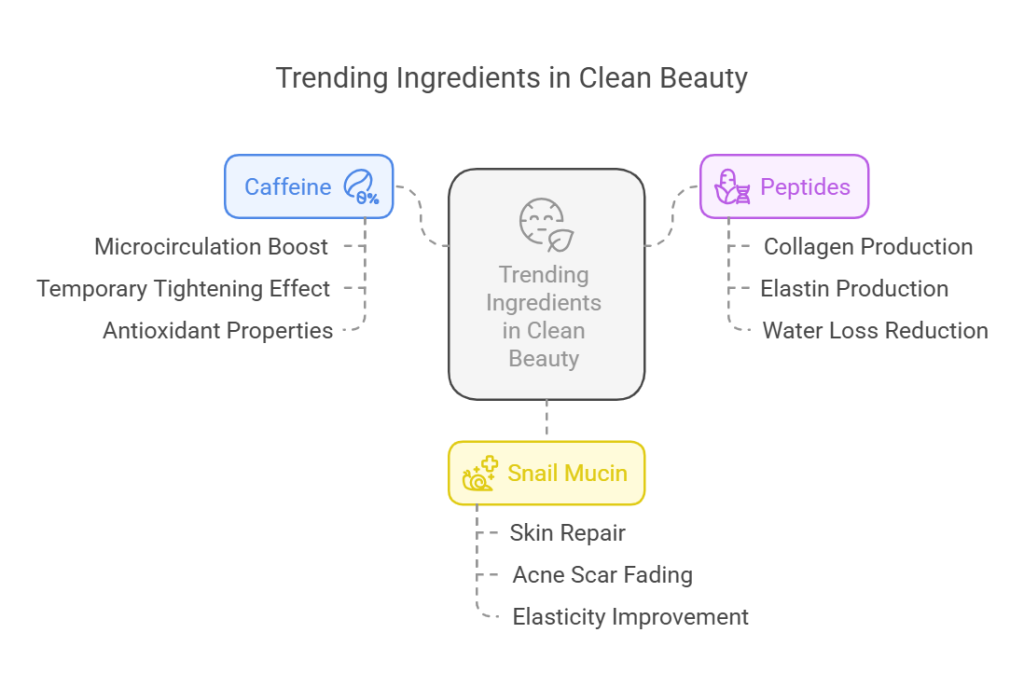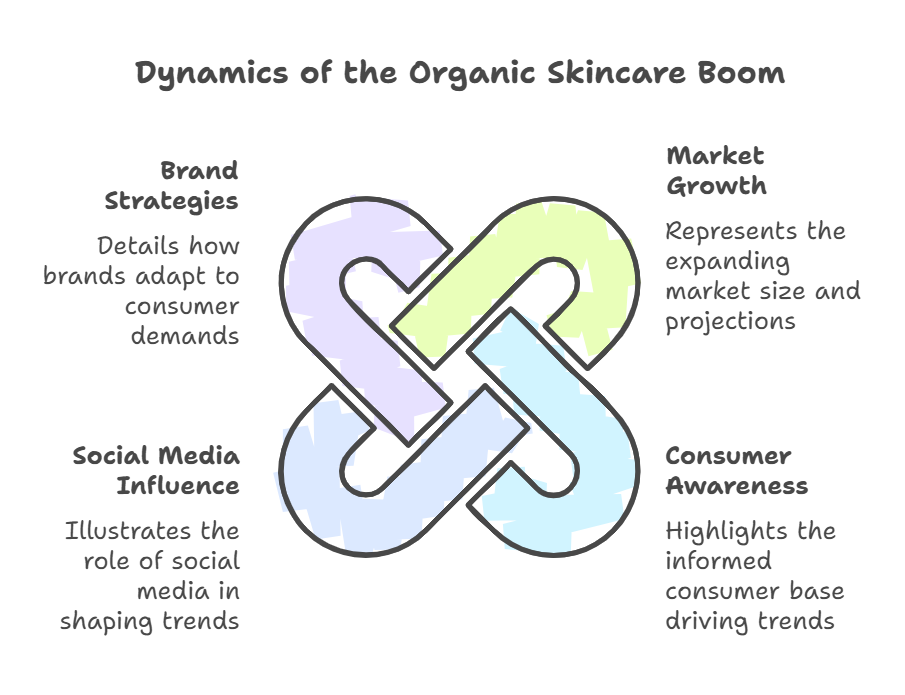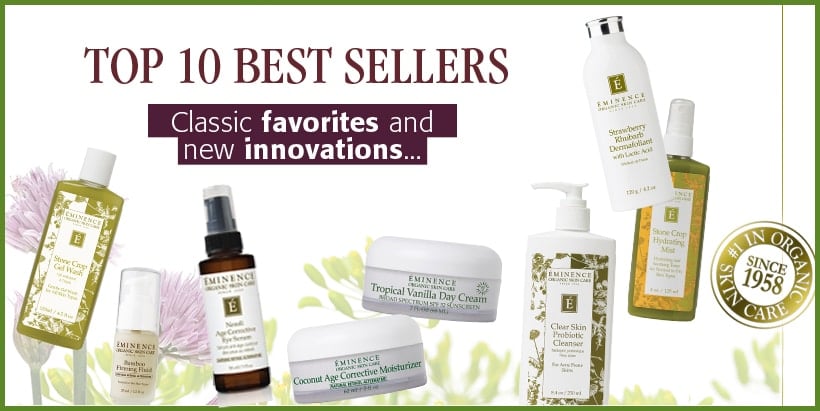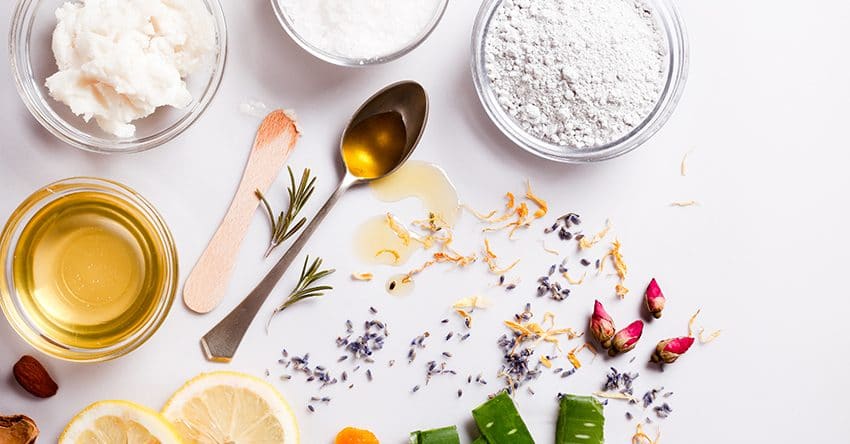Organic and natural skincare is booming, driven by consumers seeking “clean” ingredients and effective, plant-based alternatives to synthetic chemicals. The global organic skincare market reached around $9.8 billion in 2021 and is projected to grow ~8.9% annually through 2030
. Social media has also created skintellectuals – beauty enthusiasts highly informed about ingredients – which pressures brands to stay on top of the latest ingredient trends
. Below we explore emerging organic skincare ingredients gaining popularity, why they’re trending, their benefits, and how they’re used. We’ll also see how brands leverage these trends in marketing and SEO to connect with ingredient-savvy consumers.
Plant-Based Retinol Alternatives (Bakuchiol & More)
Why it’s trending: Consumers love retinol’s anti-aging results but not its irritation. This has fueled interest in gentler, natural “bio-retinols.” Bakuchiol (from the Babchi plant) is the best-known botanical retinol alternative and has surged in popularity (337K Google searches per month, +13% YoY as of early 2025)
. Search interest in “bio-retinol” overall jumped ~288% in recent years
, reflecting the demand for plant-derived retinol mimics.
Benefits and usage: Bakuchiol has a different chemistry than retinol but works similarly on skin – it stimulates cell turnover, boosts collagen, and reduces wrinkles, fine lines and hyperpigmentation without the harsh side effects
. A clinical study found 0.5% bakuchiol cream produced comparable improvement in photoaging to 0.5% retinol, but with significantly less skin scaling and stinging
. This makes bakuchiol appealing for sensitive skin or day use when retinol (which can cause sun sensitivity) isn’t ideal. Brands are formulating serums and oils with bakuchiol as a natural retinol alternative for anti-aging routines. Other plant-based retinol-like actives (e.g. moth bean extract or ramen ber (rambutan) extract) are also emerging, riding the same trend of “retinol results without retinol.”
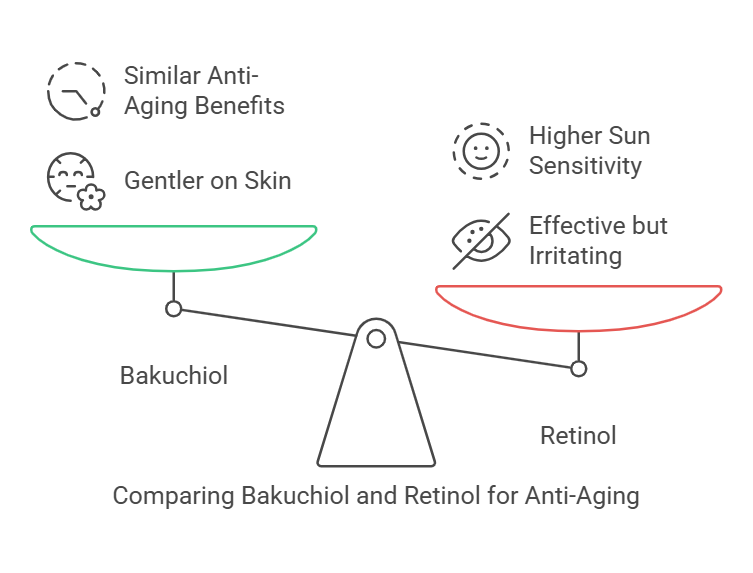
Marine Extracts: Algae and Astaxanthin
Why they’re trending: Ocean-sourced ingredients are rising stars thanks to the “blue beauty” movement emphasizing sustainable marine resources
. Both macroalgae (seaweeds) and microalgae are being incorporated into skincare for their rich bioactives and eco-friendly appeal. Algae extracts align with consumer interest in wellness and the environment, offering a natural treasure trove of vitamins, antioxidants, and minerals for the skin.
Benefits and usage: Seaweed (macroalgae like brown kelp, red algae, etc.) is packed with protective pigments and antioxidants that help these plants survive harsh conditions – those same compounds can shield our skin from oxidative stress and inflammation, helping prevent early signs of aging
. Algae extracts are used in moisturizers, serums, and masks to impart anti-aging and soothing benefits. Microalgae such as spirulina (blue-green algae) provide nutrients and a unique blue antioxidant pigment (phycocyanin) with antimicrobial properties. Spirulina extract can regulate sebum, reduce hyperpigmentation, and support the skin barrier and hydration
, making it great for acne-prone or dehydrated skin. Another marine superstar is astaxanthin, a red-orange carotenoid derived from microalgae. With antioxidant activity higher than vitamin C, astaxanthin helps slow skin aging and fights hyperpigmentation, wrinkles, and collagen breakdown
. It’s showing up in facial oils, creams, and even supplements, often marketed as a “potent natural anti-aging active.” Only a tiny amount is needed (it imparts a pink tint), and brands highlight astaxanthin’s origin (like sustainably farmed algae) and its science-backed potency in neutralizing free radicals.
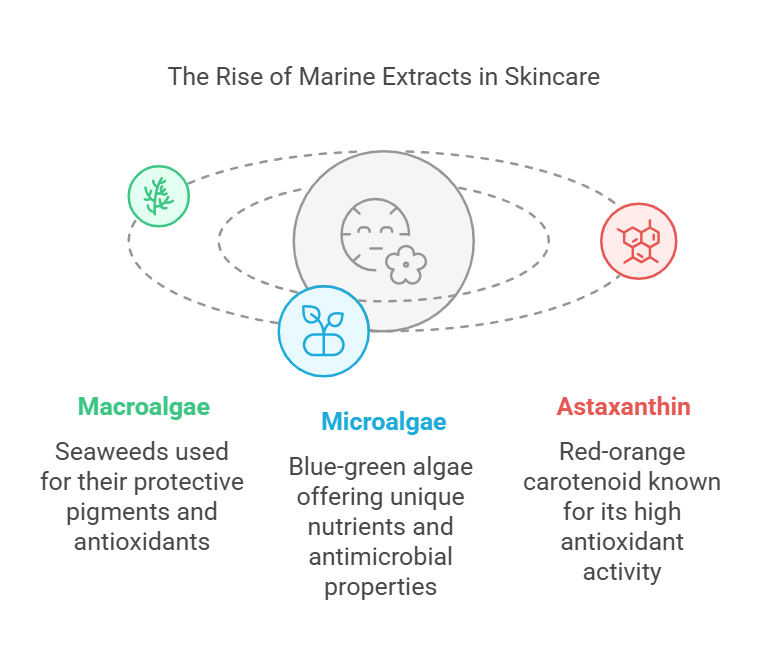
Nutrient-Rich Botanical Oils and Extracts
Plant-derived oils and extracts remain a cornerstone of organic skincare, but a few heritage ingredients are seeing renewed interest due to unique benefits:
Black Cumin Seed Oil (Nigella sativa): An ancient remedy (used in Middle Eastern and Ayurvedic traditions) now popping up in modern skincare. Recently, it’s been “in the spotlight” in both indie and mainstream beauty products
. Black seed oil is rich in essential fatty acids and contains potent compounds like thymoquinone. It has proven antioxidant, anti-inflammatory, and antibacterial properties, making it especially beneficial for acne-prone or irritated skin
. It also helps nourish with its lipids, restoring elasticity and preventing premature aging from free radical damage
. Brands are formulating this oil into facial oils, serums, and even moisturizers for oily/problematic skin, often touting its holistic healing reputation (e.g. “clearing ancient remedy”) in marketing.
Jojoba Oil: A more familiar natural oil, jojoba is experiencing a resurgence as consumers refocus on minimalist, barrier-friendly ingredients. Jojoba’s waxy composition closely mimics skin’s own sebum, making it an excellent lightweight moisturizer and barrier protector. Searches for “jojoba oil skincare” have doubled recently
, indicating renewed popularity. Many clean beauty brands highlight jojoba in face oils, cleansers, and creams for its ability to balance oil production and deliver vitamins E and B.
Superfruit Extracts (Vitamin C sources): Vitamin C has long been a star for brightening and collagen support, and it remains the most sought-after skincare ingredient (outranking even retinol in Google searches)
. Now, brands are turning to exotic fruits like Kakadu plum, acerola cherry, and camu camu – all extremely high in natural vitamin C – to infuse products with organic brightening power. For example, Kakadu plum (an Australian fruit) boasts up to 100× more vitamin C than oranges and is being used in serums and masks as a gentle, stable vitamin C source
. These botanical extracts allow brands to label products as “100% natural vitamin C” and appeal to those wary of synthetic ascorbic acid. The benefit is the same: improved radiance, fading of dark spots, and antioxidant protection for the skin.
Centella Asiatica (Cica): Centella (nicknamed cica) is a medicinal herb that exploded in Asian skincare a few years ago and has since gone global as a go-to soothing ingredient. Interest remains high – “cica” garners about 1.4 million searches per month (up 16% YoY) as of Jan 2025
– reflecting its popularity for calming sensitive or compromised skin. Rich in triterpenoid compounds, centella helps accelerate wound healing, stimulate collagen, and reduce inflammation. It’s commonly found in “cica creams,” serums, and even cleansers aimed at repairing the skin barrier, calming redness, and treating acne or eczema. Brands often market centella products with claims like “skin recovery” or “redness relief,” leveraging its dermatological backing and K-beauty origin story.
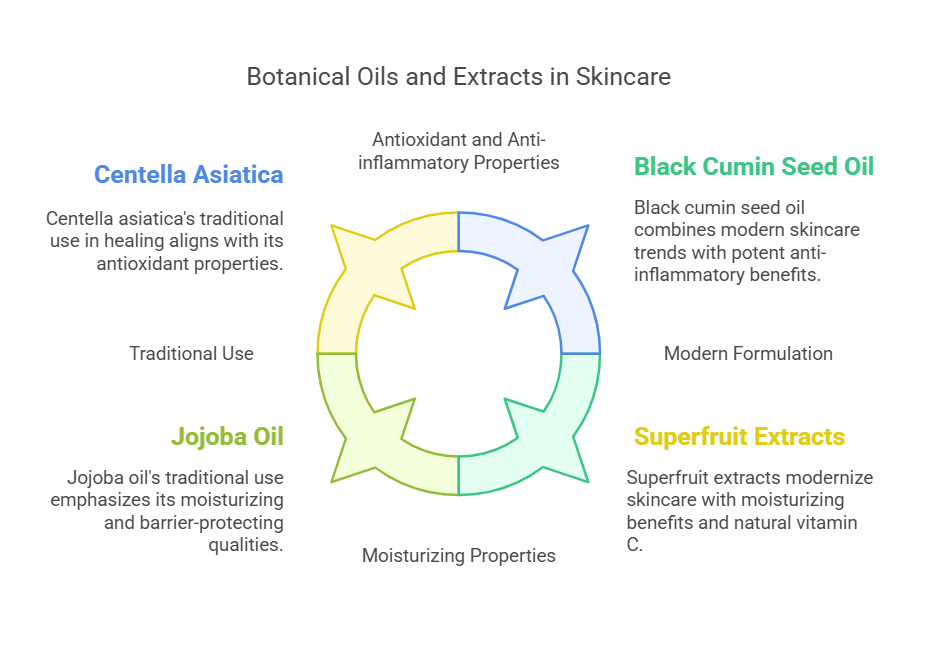
Mushrooms and Fermented Actives for the Microbiome
Mushroom Extracts: Adaptogenic fungi have made their way from supplements into topical skincare. For a few years now, ingredients like reishi, chaga, and snow mushroom have been taking the beauty industry by storm for their “magical” benefits
. Mushrooms are packed with polysaccharides and antioxidants that calm inflammation and combat aging. Notably, the snow mushroom (Tremella fuciformis) is often compared to hyaluronic acid – its polysaccharides can hold immense moisture, providing excellent hydration and plumping effects
. Other mushroom extracts (shiitake, reishi) offer antioxidant and brightening actions. These extracts are used in serums, moisturizers, and masks to boost moisture retention, improve fine lines and even out skin tone
. Brands position them as exotic, “Eastern medicine” inspired actives that support healthy aging and resilience. For example, products will highlight keywords like “adaptogenic”, “fungi power”, or “mushroom infusion” in marketing.
Fermented and Probiotic Ingredients: As the skin microbiome trend grows, probiotics and postbiotics have become key ingredients in organic skincare. 2024 has seen a shift toward biome-friendly products that nurture the skin’s good bacteria and barrier
. Ingredients like Lactobacillus ferments, bifida ferment lysate (a by-product of fermented Bifidobacterium), and other probiotic extracts are being added to creams and serums. They aim to calm inflammation, strengthen the moisture barrier, and even help with conditions like acne or eczema by restoring microbial balance
. Scientific reviews show topical probiotics can indeed reduce trans-epidermal water loss and improve dry skin by bolstering the skin barrier
. Brands often label these as “probiotic moisturizers” or “fermented essence” and market them as high-tech natural care – combining ancient fermentation techniques with modern skin science. For instance, a probiotic serum might be advertised to “boost the skin’s defenses” or “balance your microbiome for healthy, glowing skin.”
A standout from fermentation science is Ectoine, a molecule produced by extremophile microbes. It’s a lesser-known ingredient set to trend as a powerful skincare additive
. Ectoine is an amino acid derivative that these microbes use to survive extreme salt, heat, or cold, and in skincare it serves as a superb protection and hydration agent. It moisturizes, calms irritation, reduces inflammation, and fortifies the skin barrier (by decreasing water loss and smoothing skin tone)
. Because of its ability to help skin cells resist environmental stressors, ectoine is being used in “anti-pollution” or “urban defense” creams, sunscreens, and hydrating serums. Brands highlight that it’s a natural extremophile extract to intrigue consumers with the story of an ingredient born in Earth’s most hostile environments now shielding your skin.
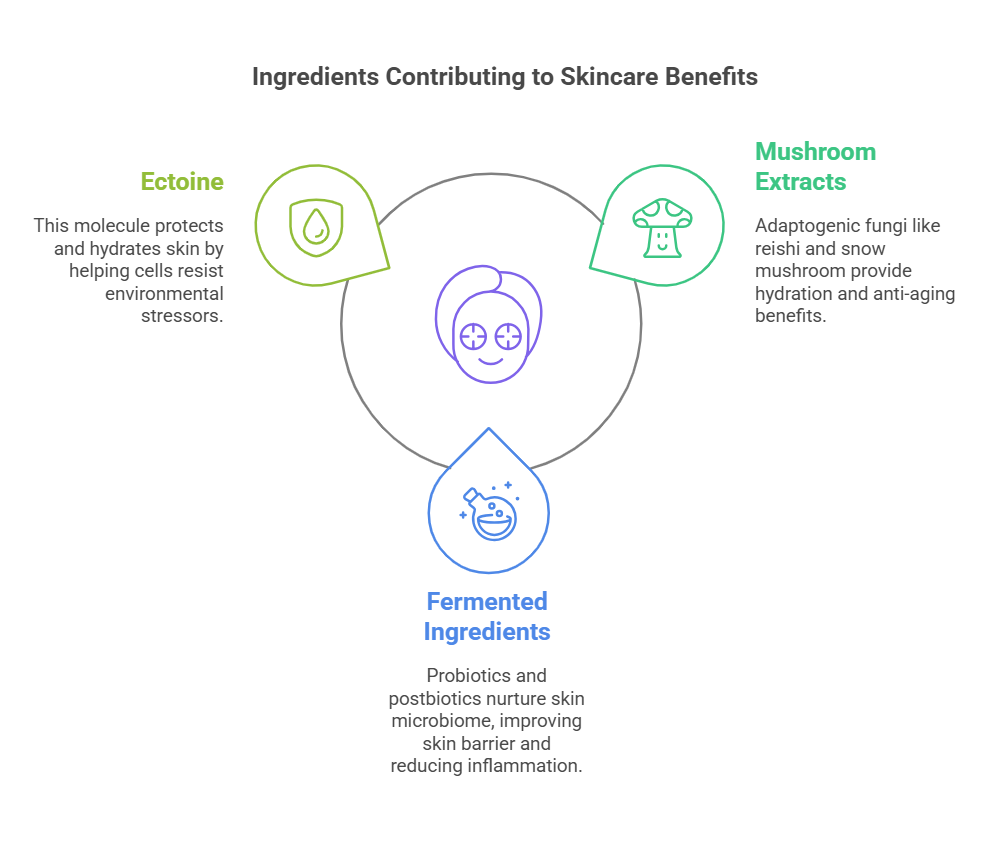
Barrier-Boosting Vitamins and Lipids
Maintaining a healthy skin barrier is a major focus in current skincare, so it’s no surprise that ingredients which support the barrier are trending.
Niacinamide (Vitamin B3): Niacinamide has essentially become a staple in both natural and conventional skincare, valued for its versatility. It’s included here because even in organic lines it’s often used (it’s a vitamin technically obtainable from natural sources, though usually lab-made). Its benefits are incredibly broad: niacinamide regulates sebum (helping control oil and breakouts), reduces inflammation and redness, fades hyperpigmentation and spots, refines pore size, smooths fine lines, and strengthens the skin barrier by boosting ceramide production
. This multi-tasking profile has made niacinamide a darling of dermatologists and influencers alike. In fact, Vogue dubbed niacinamide the “It” skincare ingredient, and searches for niacinamide (e.g. “niacinamide moisturiser”) have skyrocketed ~4,900% in the last 5 years
. We can expect its popularity to stick around, as TikTok creators constantly rave about niacinamide serums and its high efficacy with minimal irritation. In organic products, niacinamide commonly appears in serums, toners, and moisturizers – even some natural brands that avoid synthetic actives make an exception for this vitamin because it’s so effective and generally gentle.
Ceramides: Ceramides are lipids naturally found in our skin barrier, but they can be derived from plant sources or fermented yeast for use in skincare. They’re familiar but still on-trend as consumers increasingly prioritize barrier health
. Ceramides reinforce the skin’s moisture barrier – they literally “seal” the skin to prevent water loss and external irritants. Adding ceramides to creams or lotions has been shown to increase skin hydration and reduce dryness by preventing transepidermal water loss
. They also help repair a damaged barrier (useful for eczema-prone or over-exfoliated skin). Interest in ceramide-infused products grew ~38% last year, with about 32K searches per month as of early 2024
, and they’re mentioned frequently on social media in the context of barrier repair. Brands leverage this by marketing “ceramide creams” or “barrier repair moisturizers” that promise to heal and hydrate. Even in the natural sector, we see products boasting plant-derived ceramides or ceramide complexes, often combined with oils and butters to intensify the barrier support.
Natural Hydrators (Hyaluronic Alternatives): Alongside ceramides, ingredients that draw moisture to the skin are trending. Traditional hyaluronic acid is well-known, but “organic” brands often opt for bio-based or alternative hydrators. We already touched on snow mushroom (a HA analog). Another example is polyglutamic acid (PGA), a hydrating polymer from fermented soybeans that’s emerging as a mega-hydrator (able to hold 4× more water than HA). While not yet a household name, PGA and algae-derived polysaccharides are starting to appear in natural hydration serums. Aloe vera (a classic) is also experiencing steady popularity as a base for hydrating products due to the post-Covid focus on soothing, minimal ingredient formulations. These hydrators are marketed for providing dewy, plump skin and often highlighted in “hydration booster” product descriptions.

Other Notable Trending Ingredients
Caffeine (from Green Tea & Coffee): Caffeine isn’t new, but it’s seeing expanded use in clean beauty for its natural origin and proven effects. Brands are adding coffee-derived caffeine or green tea extracts (rich in caffeine and polyphenols) to products like eye creams, serums, and even scalp tonics. Why? Caffeine boosts microcirculation and gives a temporary tightening effect, which can help reduce the look of puffy eyes and cellulite, and even stimulate hair follicles
. It also has antioxidant and anti-inflammatory properties that protect against UV damage and soothe redness
. Consumer interest backs this up – Google searches for “caffeine eye cream” jumped ~270% over the last five years
as people sought solutions for dark circles and tired eyes. In marketing, you’ll see claims like “visibly de-puffs under-eyes” or “firms and energizes skin” with caffeine as a star ingredient. For example, one popular clean brand’s eye cream uses pink marine algae + caffeine and boasts that 97% of users saw fewer fine lines in 1 week
, combining an algae antioxidant with caffeine’s quick firming action.
Peptides: Peptide-based actives are hot in the anti-aging category, and now even natural-focused brands are embracing them (sometimes sourcing from plant peptides or lab-synthesizing identical compounds). These short amino-acid chains can signal skin to produce collagen or elastin, or simply form a protective film that reduces water loss and fine lines
. In 2023, “peptide skincare” interest spiked – one analysis noted searches for it nearly tripled in a quarter (up 177%)
. In particular, copper peptide (GHK-Cu), famous for its skin-regenerating ability, has gone viral on social media – the #CopperPeptide tag on TikTok amassed over 31 million views by early 2024
, and beauty editors have nicknamed peptides “Botox in a bottle”
. This shows how a once-clinical ingredient has entered pop culture. Natural brands are formulating “peptide serums” to ride this wave, often combining them with botanicals. Marketing typically highlights clinical-like results (firmer, smoother skin), with brands using both scientific jargon for credibility and buzzworthy phrases from social media to attract consumers.
Snail Mucin (Secretion Filtrate): Though not vegan or plant-based, snail mucin is often included in discussions of “organic” or natural-inspired skincare trends because it’s an animal-derived natural ingredient. It has become a viral sensation thanks to K-beauty and TikTok. Videos of the gooey snail slime being applied for glassy skin intrigued millions – for instance, COSRX’s Snail 96 Mucin Essence went insanely viral after influencers demonstrated its effects, leading the hashtag #COSRXSnailMucin to garner over 32 million views on TikTok
. The buzz is backed by benefits: snail mucin is a hydrating cocktail of glycoproteins, hyaluronic acid, and antioxidants that can help repair skin, fade acne scars, and improve elasticity. While not every organic brand will use snail mucin (especially if they are strictly vegan or cruelty-free), its trend highlights how a unique natural ingredient can create massive consumer demand via social media. Some Western brands have now launched snail-infused products or at least reference its slime-like texture in marketing for novelty. The typical messaging around snail mucin emphasizes repair (stimulating collagen, healing blemishes) and hydration, often calling it a “skin rejuvenator” or “K-beauty secret” to piggyback on the hype.
